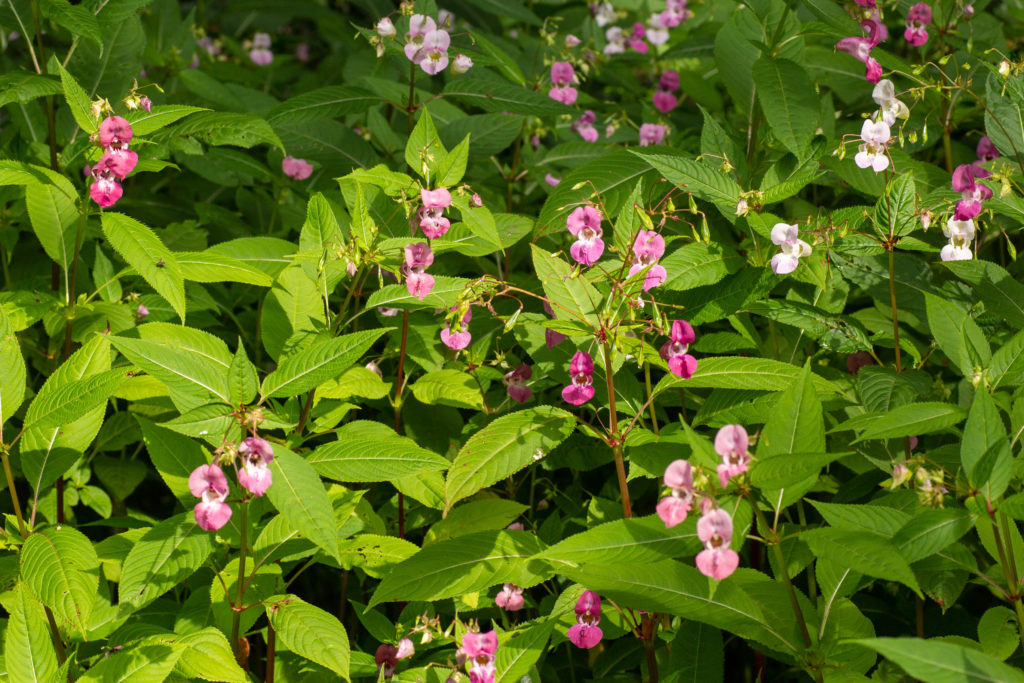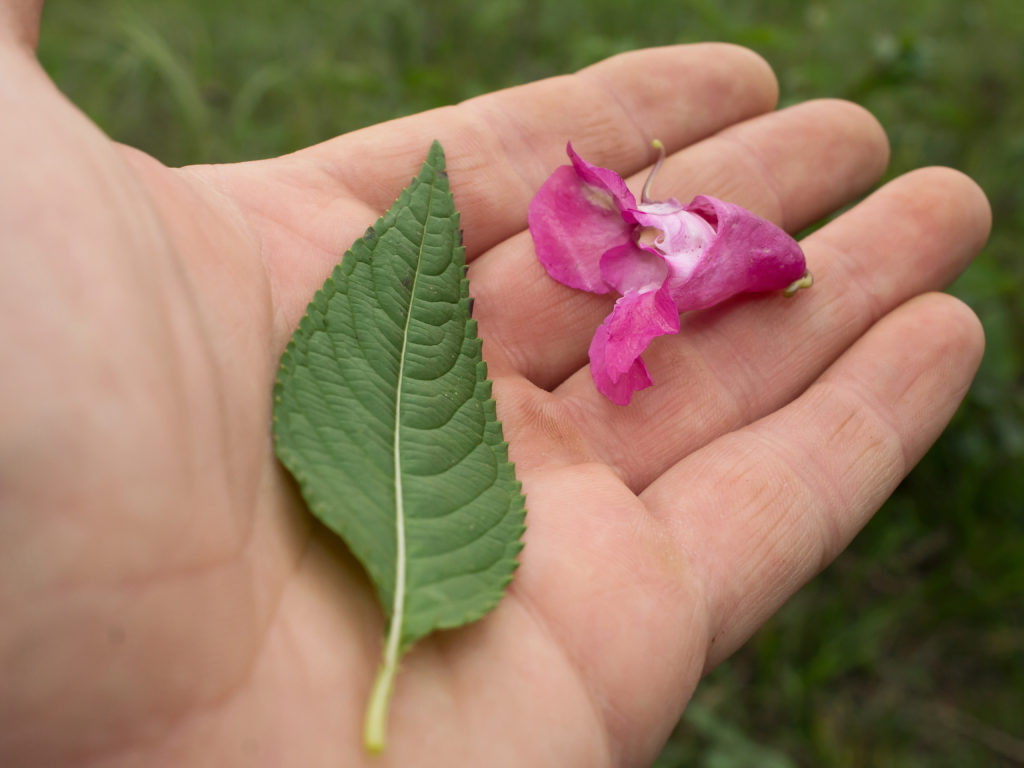Himalayan Balsam, the lesser known invasive non-native species in the UK

Japanese knotweed has risen in prominence recently, you may have even read my 2018 blog post on the subject).
It is often maligned by solicitors, surveyors and lenders as public enemy number one, and still regularly sees articles written in the mainstream media eg, The Telegraph (2019), The Independent (2019) and The Express (2019).
However, less attention is paid to Himalayan balsam (Impatiens glandulifera), a relative of the much-loved Busy Lizzie found in floral borders and displays across the UK, an annual plant which grows to about 2 m with purplish-pink slipper shaped flowers in June – August (CEH 2005).

The plant was introduced to the UK in 1839, and Himalayan balsam is now a naturalised plant, initially marketed as having ‘herculean proportions’ and ‘splendid invasiveness’ (The Open University 2005) which meant that people could buy them relatively cheaply. It is especially found in open, disused land and is particularly good at colonising river corridors (RHS 2008). It does this by tolerating low light levels and once established growing in dense populations shading out other vegetation, and so gradually impoverishing habitats by killing off other plants. Once established it can restrict access to riverbanks and paths for recreational use including anglers, walkers and watersports, impact landowners ability to conduct bank inspection and management, while causing losses in biodiversity due to the outcompeting other vegetation and forming a monoculture when established. In addition during the winter dieback its presence can cause exacerbation of erosion by leaving the banks bare, causing severe impacts on fisheries due to increases in siltation and dead plant material that can enter rivers increasing the risk of flooding.
Like Japanese knotweed, Himalayan balsam is listed on the Schedule 9 Part 2 list of The Wildlife and Countryside Act (WCA) 1981. Section 14(2), states that it is an offence to plant or otherwise cause any plant included on the Schedule to grow in the wild.
To understand just how effective this invasive species is at colonising river corridors, we need to explore the plant’s seed dispersal technique. Seeds follow flowering between June and October, 4-16 brown ‘coiled spring’ seeds are encased in distinctive green droplet shaped seed capsules with a point at one end and when ripen they ‘explode’ when touched, projecting seeds up to a distance of four metres. Many seeds drop into the water and contaminate land and riverbanks downstream, but the explosive nature of the plant’s seed release means it can spread upstream too (Plantlife 2007).
The Police, Environment Agency and Local Authorities are not obliged to control Himalayan balsam on behalf of a landowner. Any owner or occupier of land who allows an INNS plant to spread onto neighbouring land could now be found liable in common law nuisance. This has become apparent in the 2017 decision on Network Rail Infrastructure v Williams & Waistell [2018] EWCA Civ 1514, and the subsequent decision of Smith & Smith v Line [2018]. In the latter case, the court held that Mrs Line was liable in common law nuisance for a 10% diminution in value of the Smiths’ property because she permitted Japanese knotweed to spread from her land onto theirs. The rulings could therefore in theory be applied to any invasive species on Schedule 9 Part 2 list which have spread across a boundary line due to negligence or inaction.
Therefore, during eradication attempts, the aim is to deplete the seedbank in the soil while preventing fresh seed production by the plants. A program may therefore take a number of years in an isolated site. However, this is further exacerbated when, in order to eradicate the plant from a property the landowner could potentially need a catchment level approach to ensure fresh seeds are not deposited onto their land via the water course or during the next flood event. Similarly, a breakdown in co-operation from one of those upstream landowners could potentially make eradication attempts incredibly difficult or delay eradication.
To check out Groundsure’s news and latest blogs, please visit our Resources page.
References
Centre for Aquatic Plant Management (CEH), 2005. Information Sheet 3: Himalayan Balsam, available www.nonnativespecies.org/downloadDocument.cfm?id=1055
Plantlife, 2007. Himalayan balsam, available: www.plantlife.org.uk/uk/discover-wild-plants-nature/plant-fungi-species/himalayan-balsam
The Express, 2019. Japanese Knotweed UK map: What does Japanese Knotweed look like? Spread of KILLER plant. Published 17 May 2019, available: www.express.co.uk/news/uk/1128392/Japanese-Knotweed-uk-map-what-does-japanese-knotweed-look-like-knotweed-outbreak
The Independent, 2019. Troublesome triffids: How to get rid of Japanese knotweed. Published 24 March 2019, available: www.independent.co.uk/life-style/japanese-knotweed-how-to-get-rid-gardening-tips-a8833246.html
The Open University, 2005. Wanted!: Himalayan Balsam: British Isles: A Natural History, available www.open.edu/openlearn/nature-environment/natural-history/wanted-himalayan-balsam
The Royal Horticultural Society (RHS) 2008. Himalayan balsam, available www.rhs.org.uk/advice/Profile?pid=480
The Telegraph, 2019. Japanese knotweed wrongly wiping value off homes because mortgage lenders rely on ‘flawed science, published 16 May 2019, available: www.telegraph.co.uk/news/2019/05/16/japanese-knotweed-wrongly-wiping-value-homes-mortgage-lenders/
Williams F, Eschen R, Harris A, Djeddour D, Pratt C, Shaw R S, Varia S, Lamontagne-Godwin J, Thomas S E, Murphy S T, 2010. The Economic Cost of Invasive Non-Native Species on Great Britain. Centre for Agriculture and Bioscience International (CABI)
Date:
Nov 25, 2019
Author:
Chris Butler

